Easy Gooseberry Pie Recipe: 10 Tips for Sweet & Tart Flavor
This gooseberry pie recipe has some of the best pie filling I’ve ever tasted! It’s sweet and tart, just like your grandma used to make. The perfect balance of tangy gooseberries and sweet sugar creates a flavor that transports you back to summer days spent picking berries in the garden. Whether you’re a longtime fan of this old-fashioned treat or trying it for the first time, this easy gooseberry pie recipe promises to deliver a slice of pure nostalgic delight.

What Makes a Gooseberry Pie So Special?
Gooseberry pie holds a special place in American and European culinary traditions. Unlike more common fruit pies, gooseberry pie offers a unique flavor profile that perfectly balances sweetness with a distinctive tartness. This balance creates a complex, memorable taste that’s hard to find in other desserts. For more information on the potential health benefits of this delicious fruit, you can explore resources like Health Benefits of Gooseberries.
The pie’s appeal comes from its perfect harmony of flavors and textures – a flaky, buttery crust containing a filling that’s simultaneously sweet, tart, and juicy. When baked to golden perfection, the filling develops a jammy consistency that holds together beautifully when sliced, making each bite a perfect combination of crust and filling.
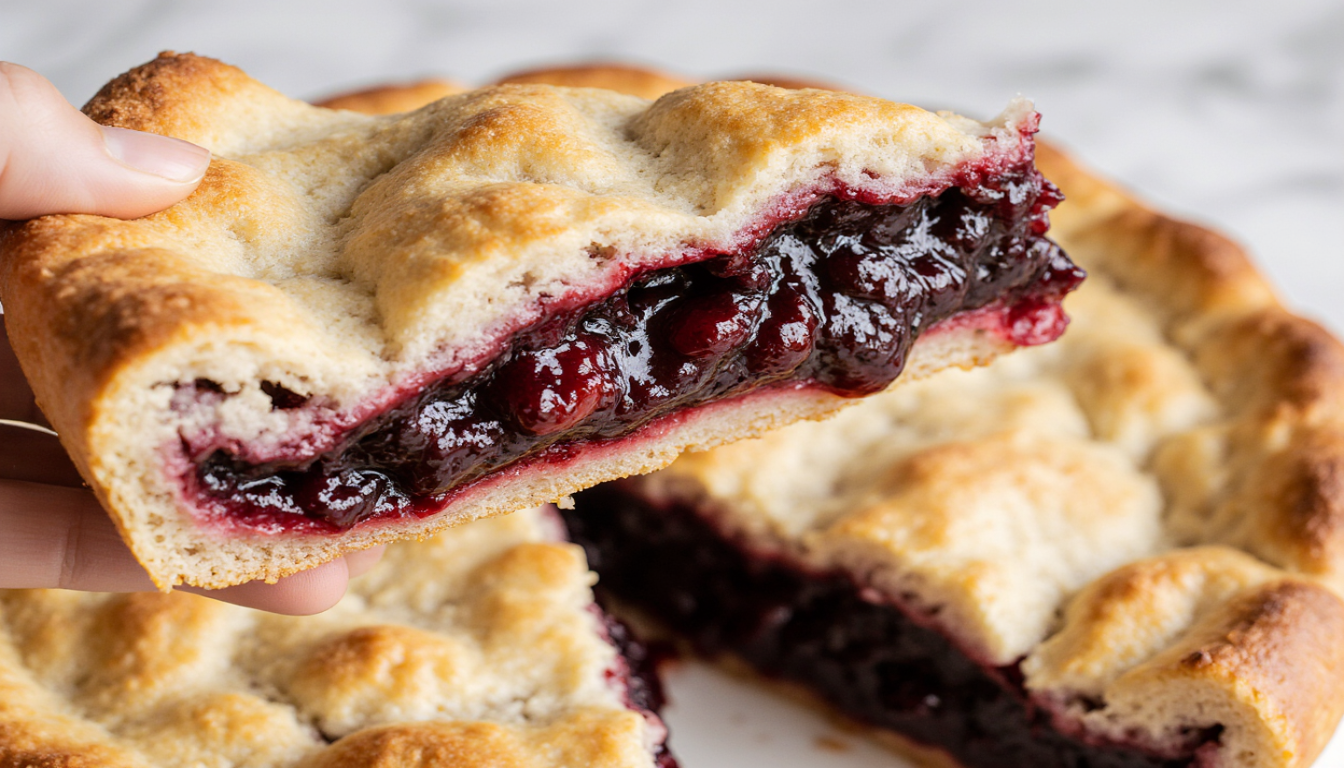
Unraveling the Unique Flavor of Gooseberries
Gooseberries have a truly distinctive taste that’s difficult to compare to other fruits. When unripe and green, they’re quite tart and tangy, similar to rhubarb but with their own unique profile. As they ripen, they develop sweetness while maintaining their characteristic tang.
The flavor is often described as a complex blend of grape, kiwi, and a hint of citrus. This unique profile is what makes gooseberry pie such a standout dessert – it’s familiar enough to be comforting yet distinctive enough to be memorable.
The Journey from Tart Green to Sweet Golden Berries
Gooseberries come in several varieties and colors. The most common are green gooseberries, which are typically used for cooking even when not fully ripe due to their pleasant tartness. As they ripen, they turn from green to a golden color, then to purple or red depending on the variety.
While green gooseberries are most traditional for pie-making, you can use any variety. The red or purple varieties will give your pie filling a beautiful pink hue, while maintaining a similar flavor profile that might be slightly sweeter than the green varieties.
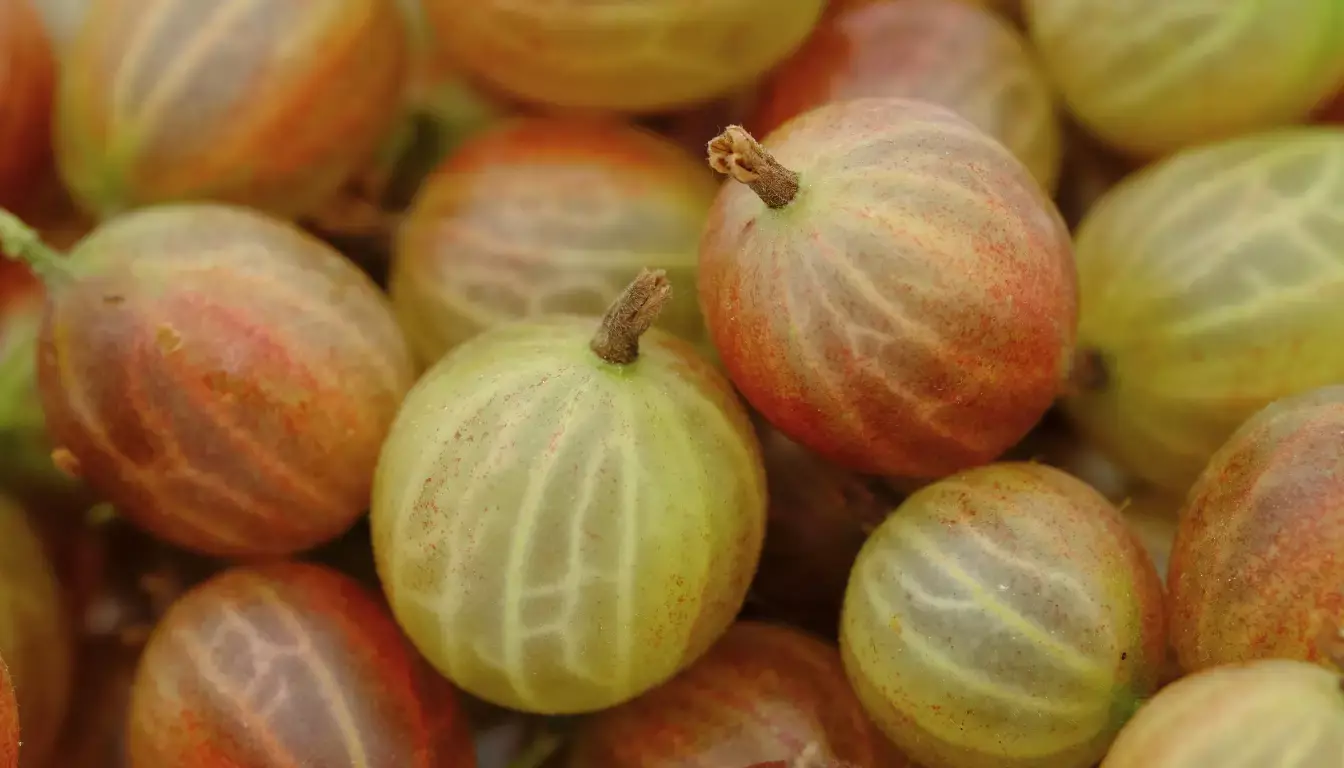
Where to Find Gooseberries for Your Pie
Finding gooseberries can be a bit of a treasure hunt, but that’s part of what makes this pie so special! Gooseberries thrive primarily in the central and northern regions of the U.S., so your ability to find fresh ones will depend on your location. For more details on growing your own and different varieties, check out guides like How to Grow Gooseberries – RHS.
Your best bets for finding fresh gooseberries include:
- Local farmers’ markets during late spring and summer
- Pick-your-own berry farms (call ahead to confirm they grow gooseberries)
- Specialty grocery stores with extensive produce sections
- Dutch or European markets, which often carry them due to their popularity in European cuisine
Fresh, Frozen, or Canned: Making the Most of What’s Available
Don’t worry if you can’t find fresh gooseberries – this recipe works beautifully with frozen or canned options too!
Fresh Gooseberries
Available seasonally (usually June-July). Look for firm berries with a slight give when gently squeezed. They should be bright in color without wrinkles.
Frozen Gooseberries
Check the frozen fruit section of specialty grocers or Dutch markets. Allow to thaw completely and pat dry with paper towels before using in your pie.
Canned Gooseberries
Oregon brand offers quality canned gooseberries. Rinse well to remove syrup and pat dry before using. They’ll still make a delicious pie!
As Robin from Pennsylvania shared: “Hello from PA, I picked a pint of gooseberries yesterday from my 20-year-old bushes. I topped and tailed and then cooked them per instructions. The pie was perfect. Thank you for your fast and easy recipe.”
Preparing Gooseberries: The Essential “Tops and Tails” Method
Before using gooseberries in your pie, you’ll need to prepare them using what’s traditionally called the “tops and tails” method. This simply means removing the small stem end (the “top”) and the flower remnant (the “tail”) from each berry.
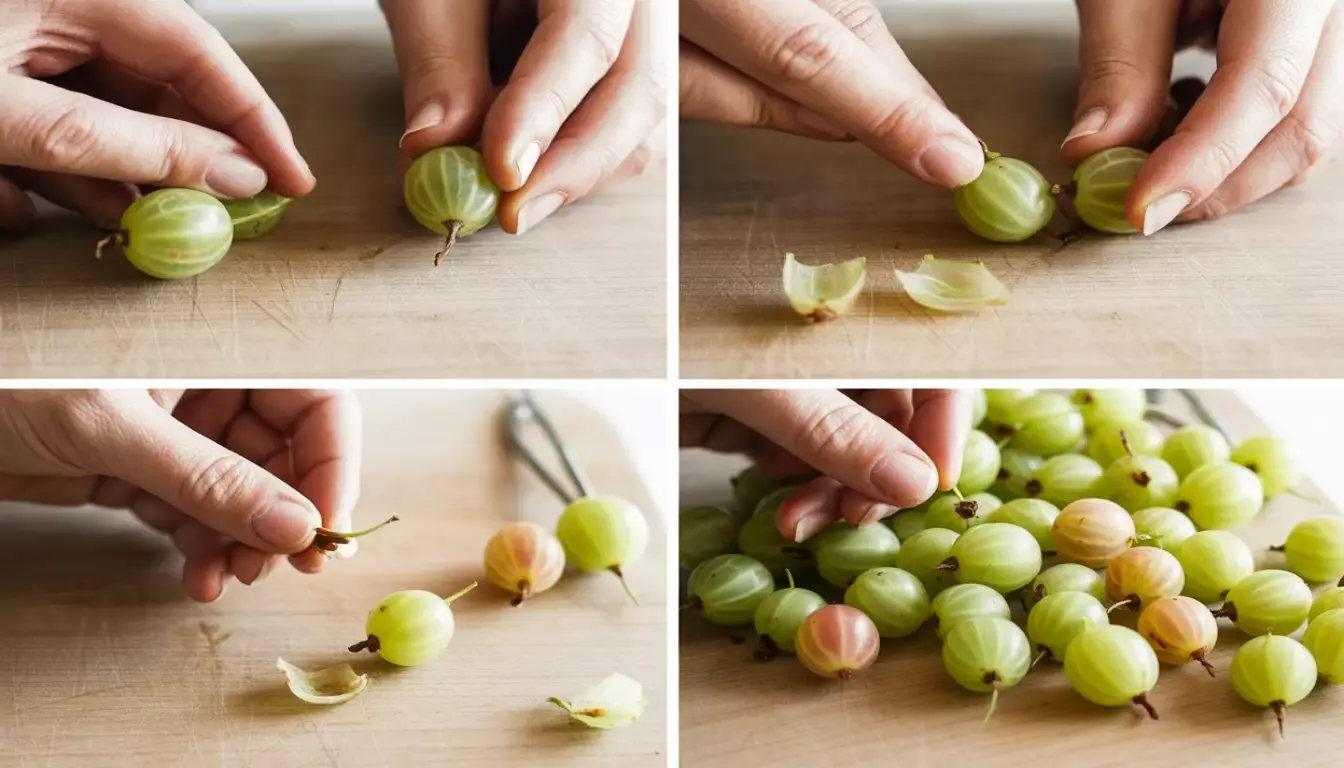
While this process takes a bit of time, it’s actually quite relaxing work. You can use:
- Your fingernails to gently pinch off each end
- A small paring knife for precision
- Kitchen scissors for a quick snip
Don’t worry about being too precise – just make sure you’ve removed the tough stem and the dried flower remnant from each berry. This prevents any unwanted tough bits in your finished pie.
I remember us children having to do bowls of gooseberries for my Oma so she could cook them into her delicious gooseberry jam. We weren’t the most reliable of workers – I’m sure there were almost as many berries popped into mouths as went into the bowls!
Crafting the Perfect Gooseberry Pie Filling
The heart of any great gooseberry pie is its filling – that perfect balance of sweet and tart flavors in a juicy yet sliceable consistency. Let’s break down the key components that make this filling so special.
The Delicate Balance of Sweet and Tart Sugar
Because gooseberries are naturally quite tart, especially the green varieties, sugar plays a crucial role in creating a balanced flavor profile. Our recipe calls for 1 cup of sugar, which creates a pleasantly tart-sweet filling that lets the gooseberry flavor shine.
Sugar Adjustment Tip: The amount of sugar can be adjusted based on your preference and the tartness of your berries. If using riper, sweeter gooseberries, you might reduce the sugar slightly. If you prefer a sweeter pie or have particularly tart berries, you can increase the sugar up to 1¼ cups.
For a different flavor dimension, you can substitute brown sugar for all or part of the white sugar. The molasses notes in brown sugar add wonderful depth to the filling.
Choosing Your Thickener: Eggs, Starches, and Beyond
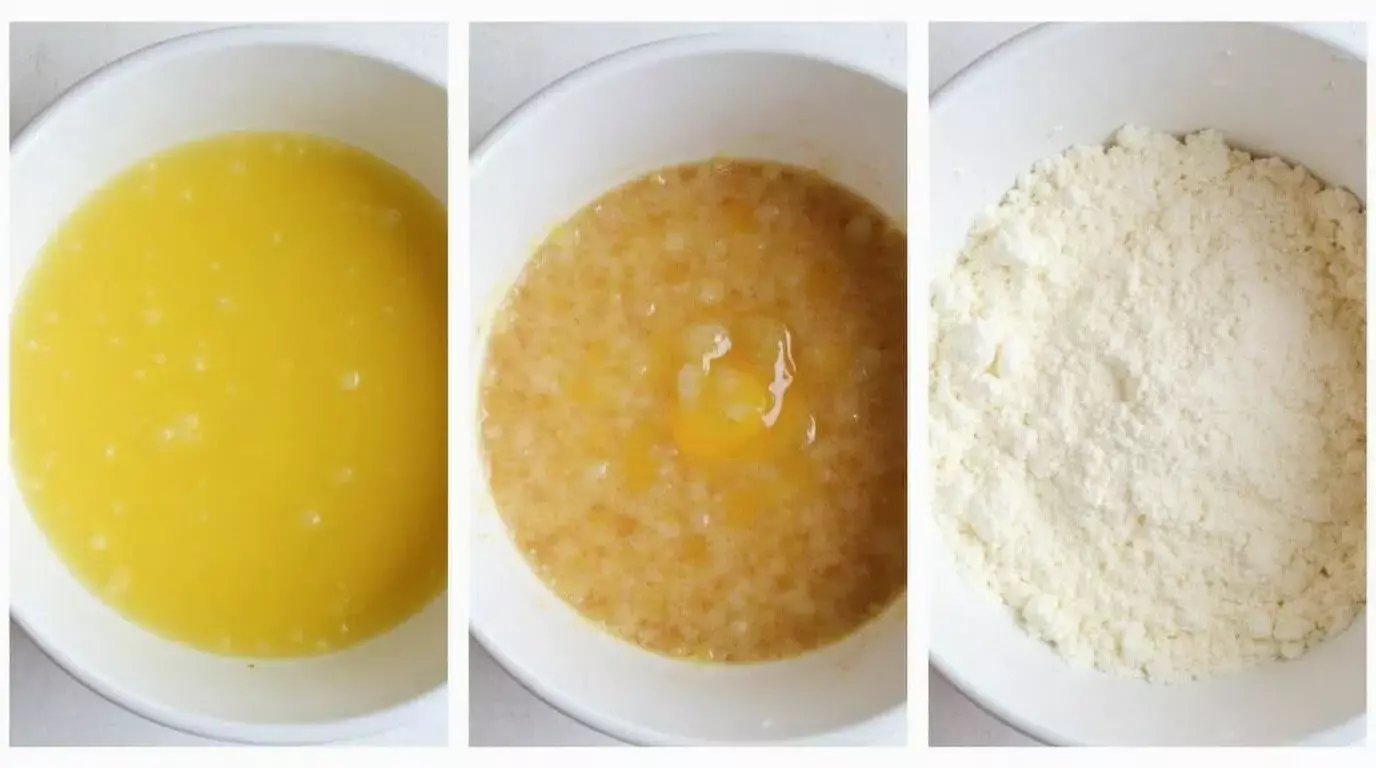
Gooseberries have a unique enzyme that can prevent some starches from thickening properly. This is why traditional recipes often use egg as a thickener. Our recipe includes egg yolks, which not only thicken the filling but also add richness.
If you prefer not to use eggs, here are alternative thickeners:
- Tapioca starch or minute tapioca: The most reliable alternative, as it works well with gooseberries’ natural enzymes. Use 3-3½ tablespoons.
- Cornstarch: Works well but may require a bit more. Whisk 1 tablespoon into 3 tablespoons of cold water and let rest for 5-10 minutes before adding to the filling.
- Flour: A traditional option, though it can make the filling slightly cloudy. Use 2 tablespoons.
The Subtle Addition of Butter and Spices
A tablespoon of butter added to the filling contributes richness and helps create a silky texture. While gooseberries have such a distinctive flavor that they don’t need much enhancement, a few subtle additions can elevate your pie:
- A tiny pinch of nutmeg (less than ⅛ teaspoon)
- A teaspoon of vanilla extract
- The zest of half a lemon (especially nice with Meyer lemon)
- A tart apple, peeled and diced, to add body to the filling
Your Pie Crust Options: Convenience Meets Tradition
While the filling is the star of a gooseberry pie, the crust is its essential partner. You have several options depending on your time, skill level, and preference.
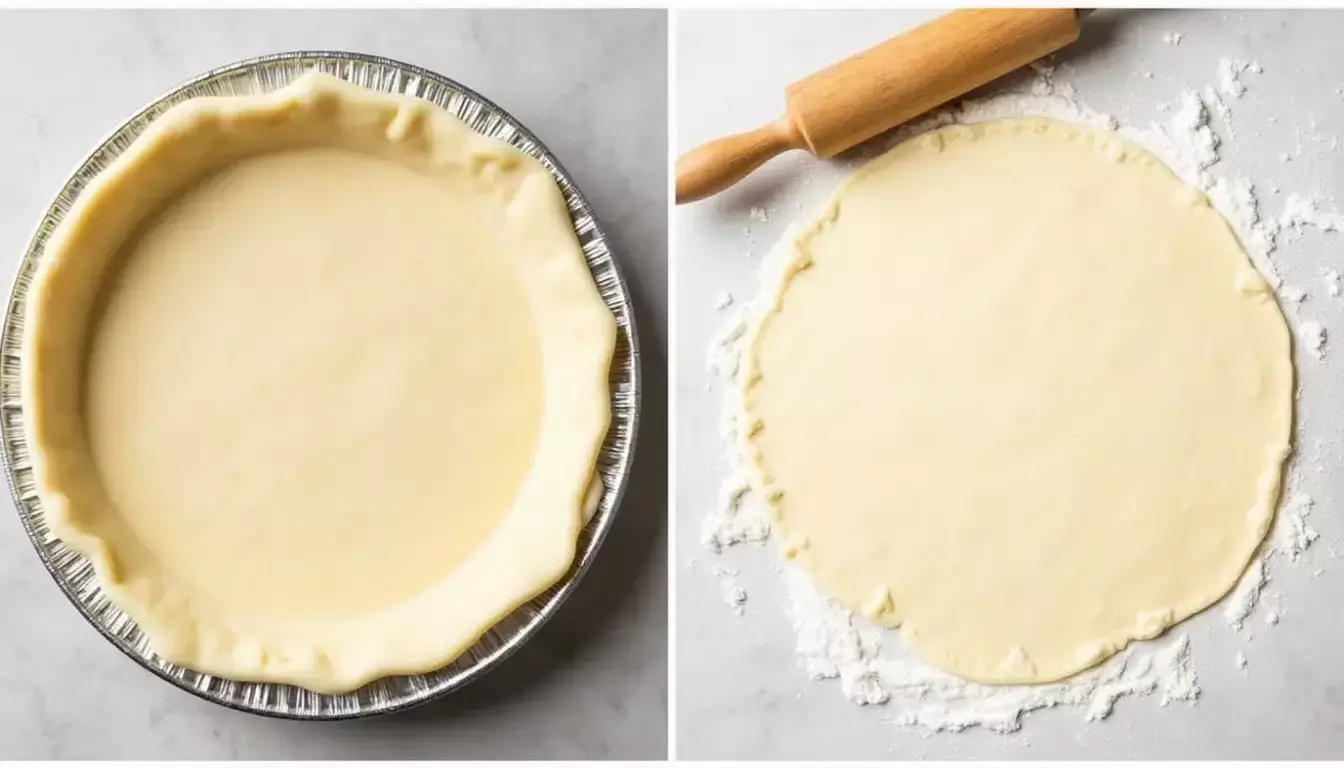
Store-Bought Convenience
There’s absolutely no shame in using pre-made pie crusts! Many excellent bakers focus their energy on perfecting the filling and use quality store-bought crusts. If using frozen crusts:
- Keep the bottom crust frozen until filling
- No need to pre-bake the bottom crust
- For the top crust, let it thaw just enough to be pliable
Homemade All-Butter Crust
If you’d like to make your own crust, this simple recipe creates a flaky, buttery base. For a more detailed guide on creating the perfect flaky crust, consider external resources like Perfect Pie Crust – Simply Recipes.
- 2¼ cups flour
- 1 cup very cold butter, diced or grated
- Pinch of sugar and salt
- ½ cup ice water (plus or minus a tablespoon)
Mix dry ingredients, cut in butter until sandy, add water just until dough forms.
Whether you choose homemade or store-bought, consider using a lattice top for your gooseberry pie. The open design allows steam to escape and creates a beautiful presentation that showcases the filling’s color.
Baking Your Gooseberry Pie to Golden Perfection
Now comes the exciting part – transforming your prepared ingredients into a beautiful, bubbling gooseberry pie! Follow these steps for the best results:

Tips for a Beautifully Baked Pie Every Time
- Preheat your oven to 425°F (220°C) for the initial high-heat period.
- Prepare your filling by combining gooseberries, sugar, your chosen thickener, and any additional flavorings.
- Pour the filling into your bottom crust. If using a store-bought frozen crust, there’s no need to thaw it first.
- Dot the top of the filling with small pieces of butter (about 1-2 tablespoons total) before adding the top crust.
- Add your top crust, either as a full crust with slits cut for venting.
- Crimp the edges to seal the top and bottom crusts together.
- For a beautiful finish, brush the top crust with egg whites or cream and sprinkle with sugar.
- Protect the edges with a pie crust shield or aluminum foil to prevent over-browning.
- Bake at 425°F for 15 minutes, then reduce the temperature to 375°F (190°C) and continue baking for 35-40 minutes until golden and bubbling.
- Allow the pie to cool completely (at least 20 minutes, preferably longer) before slicing to let the filling set.
Important Cooling Note: The cooling period is crucial! Gooseberry pie needs time to set properly. If cut too soon, the filling will be runny. For the best slices, allow at least 20 minutes of cooling, but several hours is even better if you can wait!
Serving and Storing Your Delicious Gooseberry Pie
Your patience has paid off, and now it’s time to enjoy your gooseberry pie! Here are some serving suggestions and storage tips to make the most of your creation.
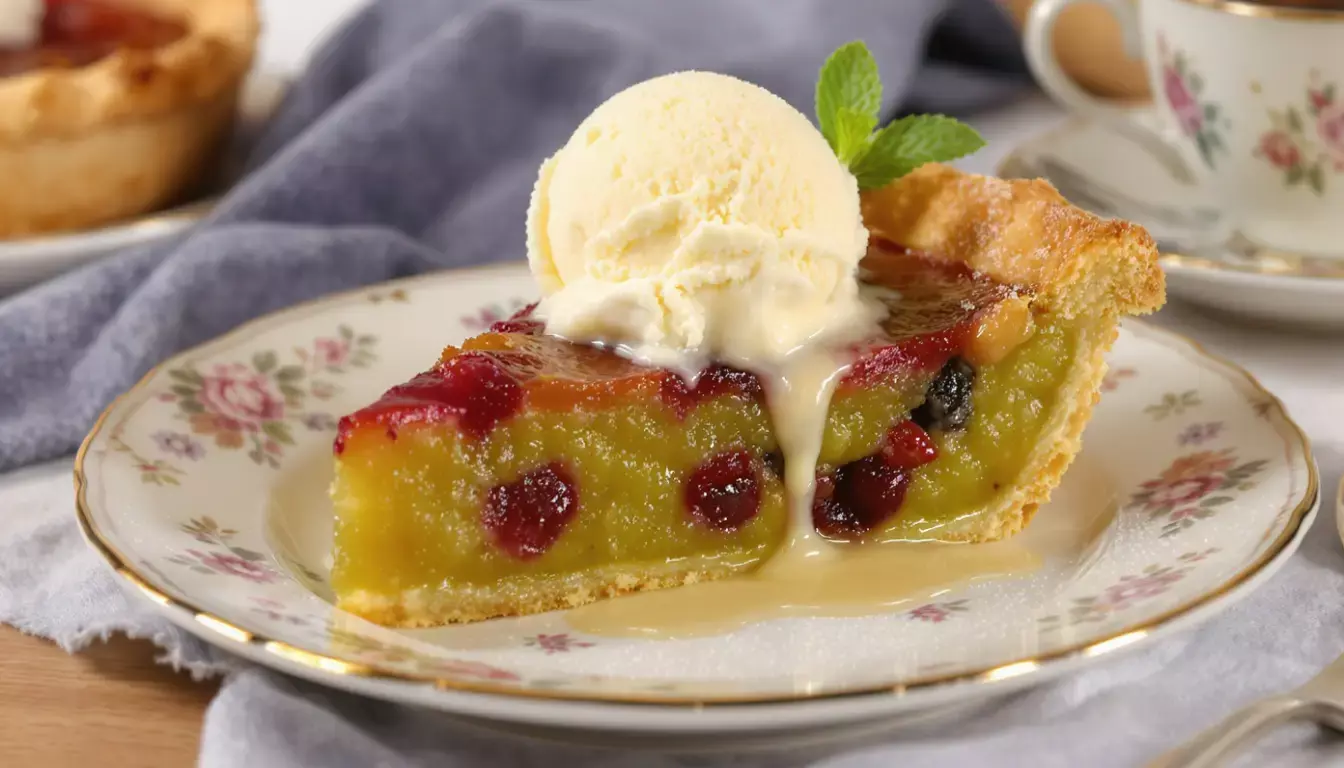
Perfect Pairings
Gooseberry pie is delicious on its own, but these accompaniments take it to the next level:
- A scoop of vanilla ice cream (the classic choice!)
- Freshly whipped cream
- A drizzle of custard sauce
- A slice of sharp cheddar cheese (an old-fashioned pairing that works surprisingly well)
Storage Tips
If you’re lucky enough to have leftovers:
- Cover with plastic wrap and store at room temperature for 1-2 days
- Refrigerate for up to 4 days for longer storage
- Warm individual slices in the microwave for 15-20 seconds before serving
- Freeze wrapped slices for up to 3 months
And yes, a small slice of gooseberry pie makes a perfectly acceptable breakfast! As one reader put it, “Life is here for us to enjoy it, right?”
Cherished Memories: Why Gooseberry Pie Resonates
There’s something special about gooseberry pie that goes beyond its delicious taste. For many, it’s deeply connected to childhood memories, family traditions, and a simpler time.

When my mom took her first bite, she said it was the “best gooseberry pie she had EVER had.” And trust me, that’s very high praise! The taste immediately transported her back to her own mother’s kitchen and summers spent picking berries from the bushes at the edge of the garden.
Many readers share similar stories of rediscovering a taste from their past:
- “This pie brought back memories of my grandmother’s kitchen. I hadn’t tasted gooseberry pie in over 30 years!”
- “My 85-year-old father said this was just like what his mother used to make. He had tears in his eyes.”
- “Finding wild gooseberries was always like a treasure hunt when I was a child. Making this pie with my own children continues that tradition.”
Whether you’re recreating a childhood favorite or starting a new tradition, there’s something wonderfully connecting about sharing this old-fashioned dessert with loved ones.
Beyond the Classic: Creative Gooseberry Pie Variations
While the traditional gooseberry pie is a masterpiece on its own, don’t be afraid to experiment with these creative variations:
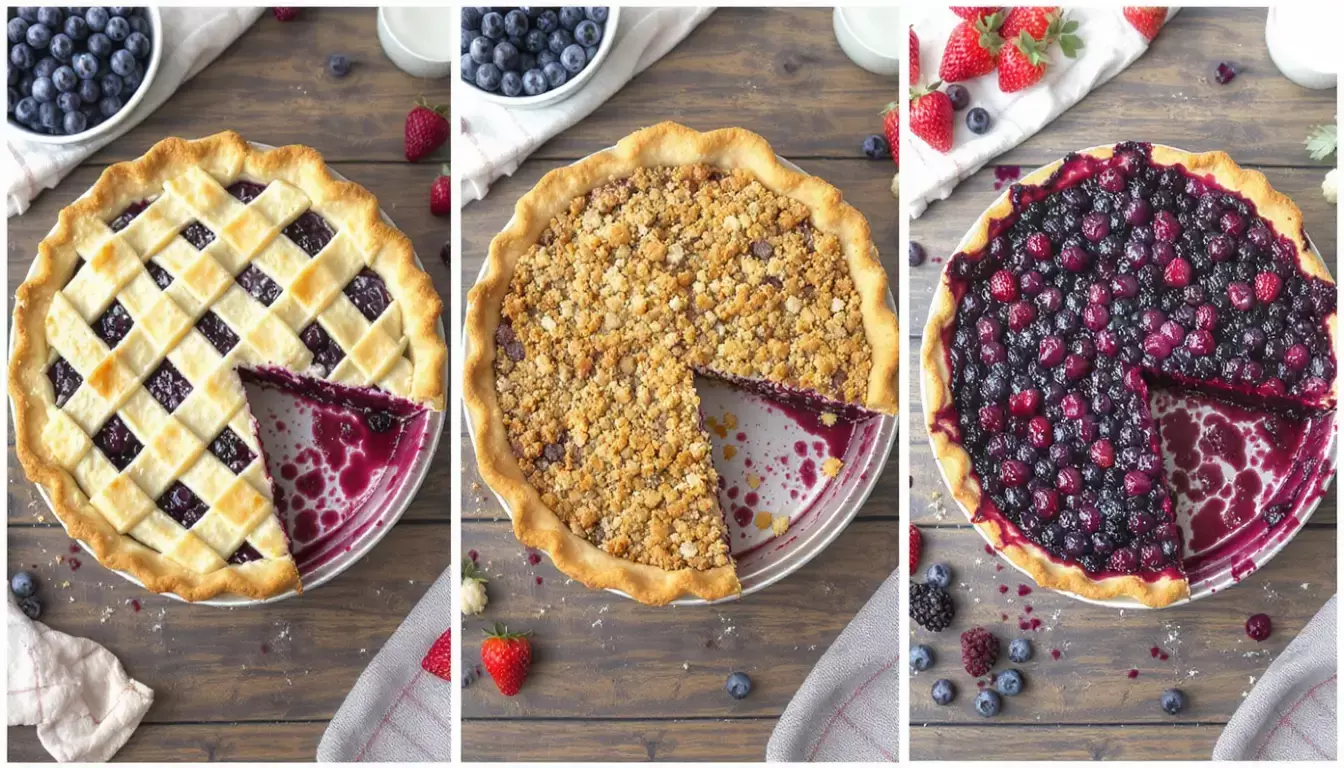
Gooseberry Crumble Pie
Skip the top crust and instead top your pie with a streusel mixture of butter, flour, sugar, and a hint of cinnamon. This creates a delightful textural contrast to the smooth filling.
“Blue Goose” Pie
Combine gooseberries with blueberries for a beautiful color contrast and complementary flavor profile. Use a 2:1 ratio of gooseberries to blueberries and adjust sugar as needed.
Gooseberry-Strawberry Pie
The sweetness of strawberries balances the tartness of gooseberries beautifully. This combination creates a stunning ruby-colored filling that’s sure to impress.
Remember that gooseberries pair wonderfully with elderflower, ginger, and citrus flavors. A tablespoon of elderflower cordial, a teaspoon of grated ginger, or some lemon zest can add an interesting dimension to your pie.
Frequently Asked Questions About Gooseberry Pie
Can I use rhubarb instead of gooseberries?
Yes! Rhubarb makes an excellent substitute for gooseberries as both have a similar tart profile. Use the same amount of chopped rhubarb as you would gooseberries. You might want to increase the sugar slightly as rhubarb can be even more tart than gooseberries.
Why is my gooseberry pie filling runny?
This is usually due to one of three issues: 1) The pie wasn’t cooled long enough before cutting, 2) Not enough thickener was used, or 3) The gooseberries’ natural enzyme affected the thickener. Try using tapioca starch next time, make sure to cook the filling until it’s visibly thickened, and allow the pie to cool completely before slicing.
Are cape gooseberries the same as regular gooseberries?
No, they’re actually different fruits. Cape gooseberries (also called physalis or golden berries) are small orange berries related to tomatillos and come in a papery husk. Regular gooseberries are larger, green to red/purple, and grow on bushes with thorns. This recipe uses regular gooseberries, not cape gooseberries.
Can I freeze gooseberry pie?
Yes! You can freeze either unbaked or baked gooseberry pies. For unbaked, freeze solid then wrap well and store for up to 3 months. Bake directly from frozen, adding 15-20 minutes to the baking time. For baked pies, cool completely, wrap well, and freeze for up to 3 months. Thaw overnight in the refrigerator before serving.
Easy Gooseberry Pie Recipe (Printable Card Format)
Prep Time: 10 minutes | Cook Time: 45 minutes | Total Time: 1 hour 15 minutes
Servings: 8 | Cuisine: American
Ingredients
- 2 pre-made pie crusts (or homemade equivalent)
- 1 pint (about 2 cups) fresh gooseberries, topped and tailed
- ½ cup water
- 1 cup sugar
- 2 tablespoons flour
- 1 tablespoon butter
- 2 egg yolks
- 2 egg whites (for brushing)
- ¼ cup sugar (for sprinkling)
Instructions
- Preheat oven to 350°F (175°C).
- In a medium saucepan, add gooseberries and water. Simmer for 2-3 minutes over medium heat. Drain most of the excess water, then return to the burner.
- Add sugar, butter, and flour to the gooseberries. Continue to simmer and stir until combined.
- Beat egg yolks in a small bowl. Slowly pour into the saucepan while stirring. Cook on medium-low heat until the mixture thickens.
- Pour the filling into the bottom pie crust (still frozen if using pre-made).
- Add the top crust. If using a full crust, cut slits for venting. Alternatively, create a lattice pattern. Trim excess dough and crimp edges to seal.
- Brush the top crust with egg whites and sprinkle with sugar.
- Cover the pie edges with foil or a pie crust shield to prevent over-browning.
- Bake for 20-25 minutes, then remove the foil/shield and bake for another 15-25 minutes until the crust is golden brown.
- Remove from oven and cool on a wire rack for at least 20 minutes before serving.
Notes
- For canned gooseberries: Rinse off syrup and pat dry before using.
- For frozen gooseberries: Thaw completely and pat dry to remove excess moisture.
- Sugar can be adjusted based on the tartness of your berries and personal preference.
- If you prefer not to use eggs, substitute 3 tablespoons of tapioca starch or 1 tablespoon cornstarch mixed with 3 tablespoons cold water.
Nutrition
Serving: 1 slice | Calories: 175kcal | Carbohydrates: 37g | Protein: 2g | Fat: 3g | Saturated Fat: 1g | Cholesterol: 50mg | Sodium: 28mg | Fiber: 2g | Sugar: 31g
A Slice of Nostalgia in Every Bite
There’s something magical about taking that first bite of gooseberry pie – the perfect balance of sweet and tart, the flaky crust, and the memories it evokes. Whether you’re recreating a childhood favorite or trying gooseberry pie for the first time, this recipe promises a delightful experience that connects you to generations of bakers before.
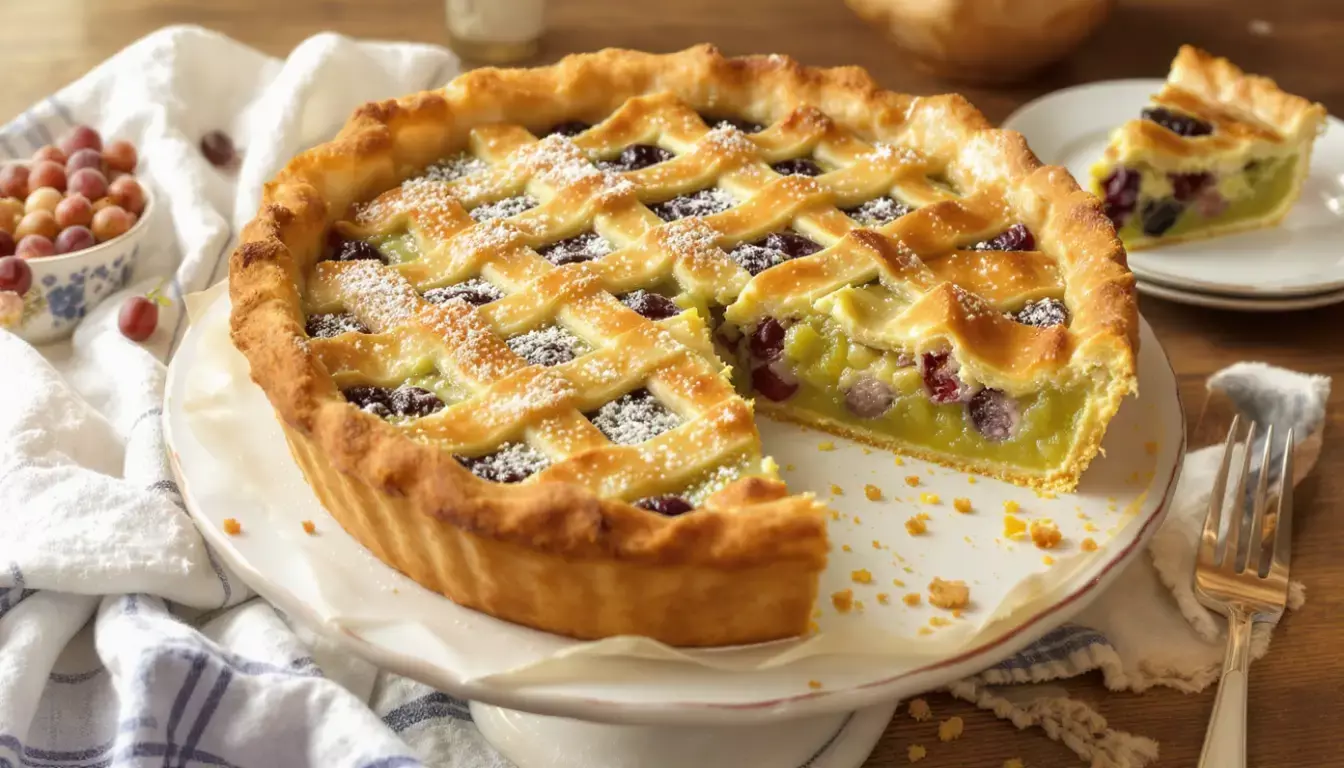
Enjoyed Gooseberry Pie Recipe!
Check out more more dessert recipes, cooking tips, and exclusive content on the blog/
Read More
Happy baking, and may your gooseberry pie bring you as much joy as it has brought to generations of pie lovers before us!


